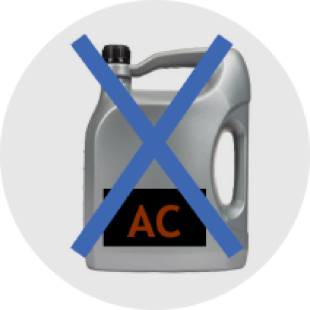ACEA Oil Sequences - Performance Claims
Lubricant marketers making claims against the ACEA Oil Sequences are required by ACEA to sign a Letter of Conformance which confirms compliance with the requirements of the European Engine Lubricants Quality Management System (EELQMS), and submit it to ATIEL, which administers the System. Please click on the button Quality Management system for more details.

ACEA Oil Sequences - Invalid Claim
• ATIEL market survey activity has identified several issues relating to invalid claims in the market.
• These include technically impossible, highly improbable, or incorrectly described or misrepresented claims.
• Could be due to lack of technical knowledge or misunderstanding of the ACEA Sequences.
• Some confusion over requirements of different releases of ACEA Sequences (i.e. 2010/2012/2016) and expiry dates
• The current issues of the Oil Sequences are ACEA 2024 for HD and ACEA 2023 for LD

ACEA Oil Sequences - Combined Claim
• Combined claims for the same lubricant against two or more Categories within the ACEA Oil Sequences are possible.
• Make products as widely applicable as possible.
• Reduce portfolio complexity and/or formulation/blending costs
• But only possible if ALL the associated chemical limits and physical testing requirements can be met.

ACEA Oil Sequences- Incompatible Claim
There are instances, however, where making a combined claim is either:
• Technically impossible due to conflicting demands of two or more Categories (eg right).
• Highly unlikely due to minimal overlap in physical and chemical properties required for that combination of Categories.
ACEA Oil Sequences- Valid Compatible Claims
The table below shows the technically possible and impossible combinations of claims that can be made against the ACEA European Oil Sequences 2022 for HD and 2023 for LD and also combinations that are possible but have restrictions that make the combination unlikely.
Please, click on the image to download the flyer on valid compatible claims.

ACEA Oil Sequences -
Invalid Claim
• ACEA Sequences state that ALL tests must be passed in order to make a performance claim.
• A claim such as ‘C2 (without fuel economy)’ is not valid against the ACEA C2 Category
• A claim such as ‘C2 (without fuel economy)/C3’ is not a valid combined claim.
ACEA Oil Sequences -
Partial or Incomplete Claims
• ACEA performance claims are self-certifying.
• ACEA ‘approved’, ‘certified’ or ‘recommended’ are not valid ways of making an ACEA claim.
• Combined claims should be separated:
• A3/B3/B4 is not valid
• A3/B3, A3/B4 is valid
• ACEA also states that the year is not to be included;
• The claim is ACEA A3/B4 NOT ACEA A3/B4-16
The YEAR numbers for ACEA Sequence is intended only for industry use and indicates the year of implementation of that severity level for the particular category. A new year number will indicate, for example, that the new test, parameter or limit has been incorporated in the category to meet new/upgraded oerformance requirements whilst remaining compatible with existing applications. An update must always satisfy the applications of the previous issue. If this is not the case, then a new category is required.
ACEA Oil Sequences - Claim validity Period
There is a validity period that applies to each of the ACEA Sequences.
To verify the ACEA sequences expiry dates for ACEA 2023 for LD and ACEA 2024 for HD, click here

• To maintain a current claim a formulation must meet the requirements of a valid ACEA sequence.
• EG: An A3/B4 formulation must meet the requirements of the ACEA 2016 sequences – ACEA 2012 became obsolete in 2018.
•Until 1st May 2024 claims against ACEA 2016 were possible for Heavy Duty but since 1st May 2023 any NEW products must meet ACEA 2022. Until 1st August 2025 claims against ACEA 2021 are possible for Light Duty but after 1st May 2024 any NEW products must have met ACEA 2023.
New claims can be made against the 2024 ACEA Oil Sequences for Heavy-Duty Engines revision 1 as of 18 December 2024.
From 18 December 2025 onwards, the 2024 ACEA Oil Sequences for Heavy-Duty Engines revision 1 are mandatory for all new claims
ACEA Oil Sequences - obsolete category claims
Claims for non-continuing class/categories such as ACEA E2 are valid if the claim is from the most recent ACEA issue when the category was valid (ie ACEA 2007).
ATIEL provides this guidance as a service to its members. It is based upon its understanding of the ACEA Oil Sequences; only ACEA can give an authoritative interpretation.
When ACEA releases a new version of its Oil Sequences, a new year number is assigned to it. The year numbers that have been used to date are: 1996/1998/1999/2002/2004/2007/2008/2010/2012/2016/2021/2022/ 2023.
Each new release updates the sequence content in some way, for example:
• new class/categories (additions)
• continuing class/categories (changes)
• and non-continuing class/categories (deletions)
New class/categories are assigned as class/category/year suffix, eg C4-16. Continuing class/categories are assigned according to the severity of the change, eg:
• a change in year suffix, e.g. C3-12 to C3-16
• a new issue number, e.g. E7-08 to E7-08 Issue 2
NOTE: Year numbers and Issue numbers are intended by ACEA for industry use only. ATIEL interprets this to mean that they are not intended for use on marketing information such as product data sheets and product labels.
Non-continuing class/categories may be removed from the new releases.


